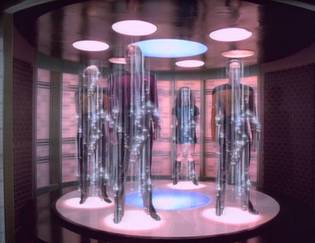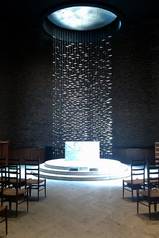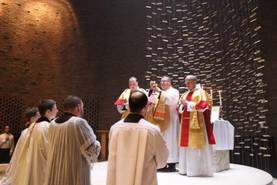
Calculus: Useful for finding the values of coefficients in the equation of a plane that is defined by two non-parallel vectors within it, but useless in determining the aesthetic value of that plane in the first place.

 N FEBRUARY 9, 2014 the Massachusetts Institute of Technology chapel was home to its first Latin Mass in over fifty years. It was a surreal experience. The chapel was built in 1955 and designed by Eero Saarinen. It is essentially a windowless brick cylinder illuminated by an oculus above a metallic tapestry in the sanctuary area. As you can see from the pictures, the sanctuary is reminiscent of the Transporter on the Starship Enterprise.
N FEBRUARY 9, 2014 the Massachusetts Institute of Technology chapel was home to its first Latin Mass in over fifty years. It was a surreal experience. The chapel was built in 1955 and designed by Eero Saarinen. It is essentially a windowless brick cylinder illuminated by an oculus above a metallic tapestry in the sanctuary area. As you can see from the pictures, the sanctuary is reminiscent of the Transporter on the Starship Enterprise.
 The very ugliness of the building made me ache with sadness for the poor engineering students who spend their days in grey classrooms and dismal labs. It is a milieu that considers aesthetics nice but superfluous and certainly inferior to “useful” research and design.
The very ugliness of the building made me ache with sadness for the poor engineering students who spend their days in grey classrooms and dismal labs. It is a milieu that considers aesthetics nice but superfluous and certainly inferior to “useful” research and design.
The positive result of having mass in such a depressing space is that every detail of the mass exuded a soothing beauty. Candles, vestments, and incense are used because of the power of their symbolic value, not because they are the most efficient materials for lighting, clothing, and perfuming.
 Juventutem Boston 1 did a spectacular job in coordinating the Solemn High Mass. Fr. John Cassani was the celebrant and Fr. Kwang Lee gave the homily. Around 150 people crammed into the tiny chapel and knelt on the hard floor. Most of the attendees were college-age and joyfully joined in singing the Mass of the Angels and the recessional hymn, “Faith of Our Fathers.”
Juventutem Boston 1 did a spectacular job in coordinating the Solemn High Mass. Fr. John Cassani was the celebrant and Fr. Kwang Lee gave the homily. Around 150 people crammed into the tiny chapel and knelt on the hard floor. Most of the attendees were college-age and joyfully joined in singing the Mass of the Angels and the recessional hymn, “Faith of Our Fathers.”

NOTES FROM THIS ARTICLE:
1 N.B. Juventutem Boston is organizing three more Traditional Latin masses at St. Paul’s church in Cambridge on February 23th, March 25th, and April 27th. For more information, visit their website (juventutemboston.com) or their facebook page.

